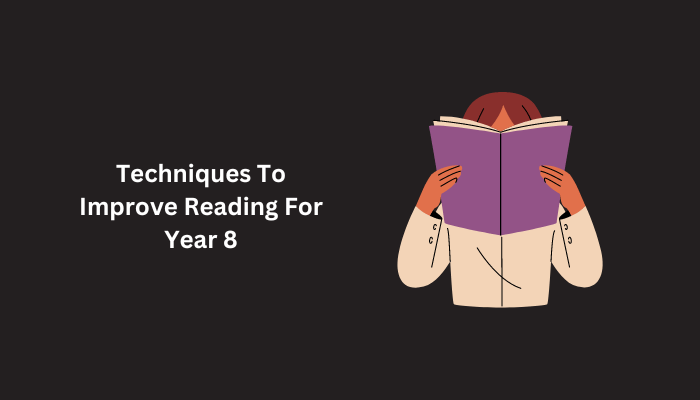In Year 8, students have to contend with increasingly complex texts in multiple subjects, which requires a deeper understanding of the content. Hence, reading comprehension becomes a crucial skill that can pave the way for their academic success.
During Year 8, students may be required to analyze literature in English class, interpret historical documents in Social Studies, or comprehend scientific texts in Science class. To do so successfully, they need strong comprehension skills to extract meaning from the text. They also need to interpret the information effectively, draw connections between ideas, and form informed opinions, all of which is based on their reading comprehension ability.
Since this is such a crucial skill, let’s look at techniques to enhance it, in the next section.
Techniques for Improving Year 8 Reading Comprehension Skills

To help improve reading comprehension skills of Year 8 students, outside the classroom, you need to provide them with age-appropriate reading materials that cater to their interests. Also consider incorporating interactive activities that build reading skills.
Another way to enhance students’ reading comprehension is by introducing a variety of genres such as fiction, non-fiction, poetry, and biographies. This opens their mind to different writing styles and themes, which encourages critical thinking and creativity, along with improving reading comprehension.
However, there are some specific techniques that can be used to develop key aspects of the reading comprehension skill. Let’s look at a few of them:
Context Clues
Context clues are helpful in extracting meaning from unfamiliar words. Learning how to use context clues can boost vocabulary development and reading proficiency.
Year 8 students should be able to distinguish between at least the following types of context clues:
- Synonym Clue: Using another phrase/word in the sentence that is similar in meaning to infer the unfamiliar word’s meaning. E.g., “The hikers were exhausted after their long trek through the mountains. Their legs felt weak and trembling, making it difficult to continue.”
The unfamiliar word is trembling. The phrase “legs felt weak and trembling” suggests that it could mean “shaking.”
- Antonym Clue: Using another phrase/word in the sentence that is opposite in meaning to infer the unfamiliar word’s meaning. E.g., "The house was immaculate, not a speck of dust to be seen."
The unfamiliar word is immaculate. However “not a speck of dust” suggests that it could mean “very clean.”
- Definition Clue: Using another phrase/word in the sentence that directly defines the word. E.g., “The movie featured an enigmatic character who spoke in riddles and always seemed to be hiding a secret.”
The unfamiliar word is enigmatic. The phrases “spoke in riddles” and “hiding a secret” suggest that it could mean “mysterious.”
- Description Clue: Using another phrase/word in the sentence that describes the word without directly defining it. E.g., “The abandoned house sat on the hill, its windows boarded up and paint peeling from its walls. An eerie silence surrounded it, broken only by the occasional creak of the rusty swing set in the overgrown yard.”
The unfamiliar word is eerie. The description of the scene suggests that it could mean “feeling of strangeness or spookiness.”
Setting up interactive exercises to identify and analyze context clues can be a fun group activity that helps students learn new vocabulary.
Also Read: Interactive Online Classes For Kids
Figurative Language
Teaching students to infer meaning via figurative language is an excellent way to expand their vocabulary and show them creative ways to form sentences. Similes, metaphors, inanimate object personification, and exaggeration are some examples of figurative language that Year 8 students can benefit from.
Poems and creative writing worksheets can be used to introduce these concepts to students. Practicing using figurative language via hands-on, interactive activities help cement these concepts.
Encouraging students to read literary pieces rich with figurative language can enhance their linguistic skills, guide them to use words in a creative manner, and appreciate literature.
Literary Genres and Structure
Introducing Year 8 students to a variety of literary genres can expose them to a variety of writing styles and structures, helping them become more confident in reading different kinds of texts. It also helps broaden their vocabulary and subject matter knowledge as each genre focuses on different topics and themes.
Nonfiction may require them to understand arguments and counter-arguments, whereas fiction would provide a better understanding of characters and story structure. And genres like science fiction or mystery require students to deduce information from clues. Thus, genre and structure knowledge can enhance students’ critical thinking and analytical skills. It can help them make predictions, infer meanings, and analyze themes more effectively.
Mastering the Main Idea
A crucial skill that is transferable across subjects is “mastering the main idea.” Whether it’s history, science, or literature, analyzing the structure of the text can help students uncover the main idea. By identifying and understanding it, they will be able to improve their comprehension of the text.
By analyzing the introduction, body paragraphs, and conclusion of a passage, students can identify key points and themes that contribute to the central message.
There are various strategies for identifying the main idea of a text:
-
Highlighting key points and themes in the introduction, body paragraphs, and conclusion.
-
Looking for repeated themes or ideas throughout the text.
-
Skimming the text and scanning for frequently repeated words and phrases.
-
Summarizing each paragraph.
Some effective ways of grasping the main idea is for students to answer questions based on the text, or rewriting the text in their own words. By practicing this skill, Year 8 students can become more adept at extracting essential information from written material.
Developing a Critical Perspective: Point of View
The “point of view” technique is crucial in helping students develop empathy, critical thinking, and a deeper connection with the text they are reading. By identifying and analyzing different points of view, students can gain new perspectives on the text which can aid their understanding of the concept. Following the story from different perspectives can also create a sense of intimacy and connection with the specific point of view, making the reading experience more engaging and interesting.
Activities involving identifying pronouns, narrator’s voice, and rewriting scenes from different points of view can enhance students’ ability to interpret and evaluate the content.
Summarizing Techniques
Learning to summarize texts is a skill that comes in handy in almost every subject, making it an essential skill for academic success. Summarizing helps students focus on the key ideas while ignoring the unnecessary details. This enhances retention of information, interpretation and analysis skills, and communication skills.
There are various techniques that students can use to improve their summarizing skills, including:
-
Identifying topic sentences, which often express the main idea of a paragraph.
-
Underlining key points, important vocabulary, or jotting down notes while reading.
-
Using markers to highlight the main idea and key supporting details in different colors.
-
Visually organizing the main ideas by using charts, mind maps, or fill-in-the-blank templates.
-
Creating a list of keywords or phrases that captures the essence of the text.
-
Rephrasing information in their own words by varying sentence structure and using different words.
Incorporating these summarizing techniques can help Year 8 students develop strong reading comprehension skills, and become more effective critical thinkers and communicators.
Tone and Voice in Reading
Understanding and interpreting text is greatly influenced by how it is written, i.e., tone and voice. It affects how students perceive the text and has a direct impact on comprehension and engagement.
The author’s attitude or feeling comprises the tone, while their unique writing style constitutes the voice. Being able to distinguish between different tones and voices can help students understand underlying emotions and intentions behind the words.
Exercises like analyzing passages from different genres can help students become more sensitive to the tone of the text, and also how the tone contributes to the overall meaning. Another exercise could be rewriting a passage with a different tone or voice to see how it changes the meaning conveyed by the text.
Consistent practice and active participation in tone and voice exercises can help students develop a deeper understanding of the text, and enhance their emotional intelligence. In a way, understanding tone and voice in text can set the stage for their future success in academics and life.
Conclusion
We hope this article has convinced you of how enhanced reading comprehension for Year 8 students can contribute toward their academic success. By incorporating the various techniques discussed in this article, we hope you can assist students improve their year 8 reading comprehension skills and gain a deeper understanding of complex texts.





















